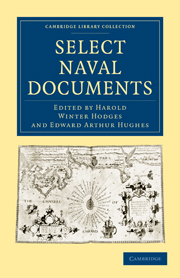Book contents
- Frontmatter
- Preface
- Contents
- LIST OF PLATES
- ILLUSTRATIONS IN THE TEXT
- ABBREVIATIONS
- HENRY VIII
- ELIZABETH
- JAMES I AND CHARLES I
- THE COMMONWEALTH AND PROTECTORATE
- THE RESTORATION NAVY
- WILLIAM III AND ANNE
- THE PEACE PERIOD AND NEED FOR REFORM
- WAR OF AMERICAN INDEPENDENCE, 1778–1783
- REVOLUTIONARY AND NAPOLEONIC WARS
- INDEX
THE PEACE PERIOD AND NEED FOR REFORM
Published online by Cambridge University Press: 07 September 2010
- Frontmatter
- Preface
- Contents
- LIST OF PLATES
- ILLUSTRATIONS IN THE TEXT
- ABBREVIATIONS
- HENRY VIII
- ELIZABETH
- JAMES I AND CHARLES I
- THE COMMONWEALTH AND PROTECTORATE
- THE RESTORATION NAVY
- WILLIAM III AND ANNE
- THE PEACE PERIOD AND NEED FOR REFORM
- WAR OF AMERICAN INDEPENDENCE, 1778–1783
- REVOLUTIONARY AND NAPOLEONIC WARS
- INDEX
Summary
Out of the long period of warfare (1688–1713), which ended with the Peace of Utrecht, Great Britain emerged as the supreme maritime power.
During the succeeding period of peace which coincided roughly with the administration of Sir Robert Walpole, when a French alliance was maintained, the efficiency of the Navy was allowed to decline, partly no doubt from the lack of serious foreign competition, but mainly for want of cleanhanded and disinterested governmental control. A period of ‘dry-rot’ set in affecting all departments of the service.
The extent of the mischief is measured by the failures of the War of Jenkins's Ear and by the conspicuous blunders committed during the earlier years of the War of Austrian Succession.
The need for drastic reforms is illustrated by the extracts which follow. They serve to show that then, as always, there were senior officers in the service who were fully alive to the dangers of administrative corruption and sluggish adherence to strategical and tactical formulas.
The triumphs of the Seven Years' War (1756–63) would have been impossible without the professional zeal of Vernon and Anson.
MANNING A SQUADRON
The problem of securing adequate supplies of able seamen was present throughout the eighteenth century, and was never satisfactorily solved. The extract here printed affords a classical example of the haphazard methods adopted for manning a squadron.
Anson's Voyage round the World, 1740–4, by Richard Walter, M.A., Chaplain of the Centurion, p. 5.
- Type
- Chapter
- Information
- Select Naval Documents , pp. 116 - 144Publisher: Cambridge University PressPrint publication year: 2009



